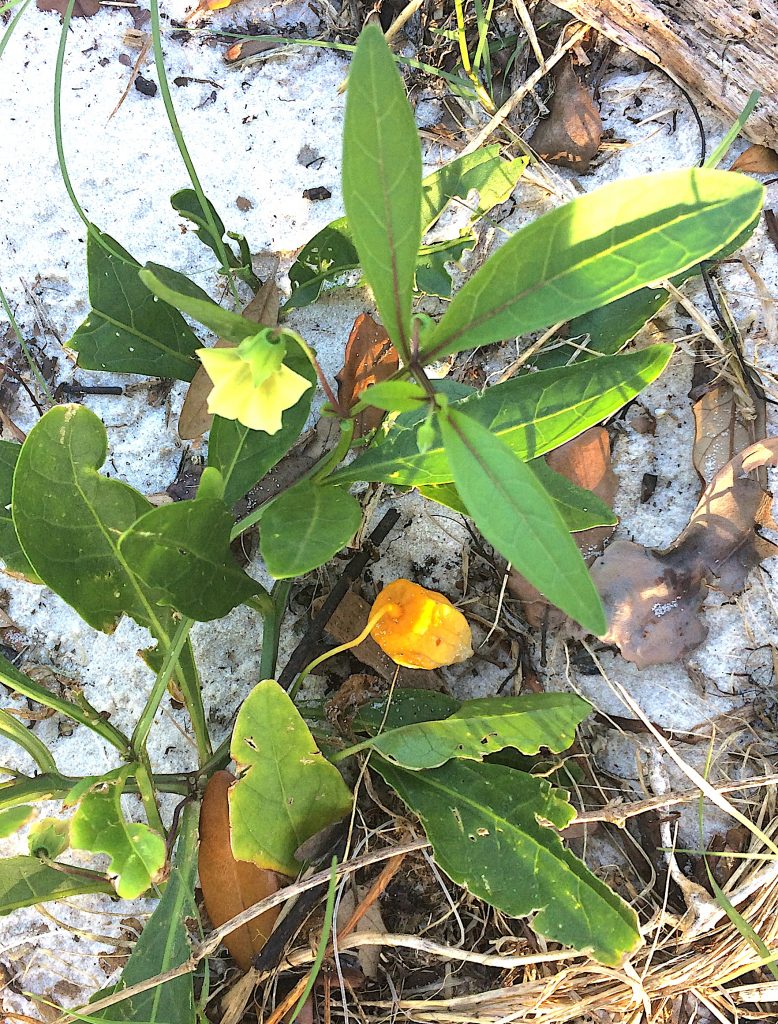
Ground cherries locally tend to have two seasons, spring and fall. They can fruit in between but there tends to be more fruit at those two times. Perhaps because of a lack of rain until recently the Ground Cherries have been few until this past weekend. Our foraging class at Ft. Desoto in St. Petersburg found many ripe ones.
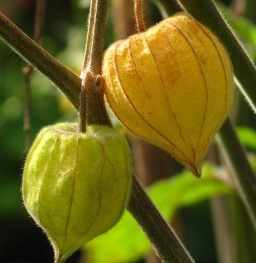
There are only two precautions I know of about “wild” Ground Cherries. The first is that if the berry is really bitter don’t eat it raw. Try cooking it. And there is an ornamental species that escapes cultivation and has red husks. Best advice is to avoid that one. Ground Cherries are also a commercial crop and called Cape Gooseberries. One wild species that does well under personal cultivation is the Cutleaf Ground Cherry, . It will grow well in your home garden but you do have to collect the seeds from the wild. To read more about Ground Cherries go here.
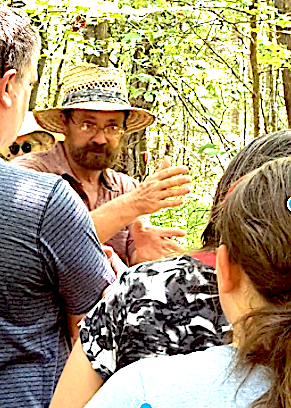
My foraging classes in South Carolina are on and people are signing up. I will be in Honea Path July 13th and 14th with two classes each day, approximately 9 a.m. and 1 p.m. at the Putney Farm, 1624 Taylor Road, Honea Path. There may be a small variation in the schedule between now and then but that’s the foraging plan at the moment. These are hands-on classes. We wander around the garden and yard of the farm and surrounding area looking at wild and or escaped edibles. For more information or to get on a list for a class email either me at GreenDeane@gmail.com or the Putney Farm at putneyfarm@aol.com. There is also more information directly below in Foraging Classes.
If you could choose one wild plant to become a commercial product, what would it be?
Many people have tried to make poke weed (Phytolacca americana) a green in your local grocery but toxicity and the required two-boilings have always plagued its commercialization. The ground nut (Apios americana) was one of the original exports from colonial America but it has at least a two-year growth cycle. Louisiana State University (1984-96) developed a commercial variety but the program disappeared when the professor-in-charge, Bill Blackmon, changed colleges. In 1962 Professor Julia Morton of the University of Miami recommended Spanish Needles (Bidens pilosa) become a commercial product. More than half a century later that hasn’t happened, perhaps because of flavor or the fact it can grow almost anywhere as a weed. My candidate for a new food crop would be Suaeda linearis, Seablit.
Seablite has everything going for it except perhaps for its name. It’s mild but tasty, has excellent texture, can be eaten raw or cooked though cooked is the usual way. It’s nutritious, stores well, looks good, easily grows in salty ground (read unused land) and even feels good to handle. About the only downside, for me, is that I have to drive about 60 miles to get some. I need to introduce it to my garden.
Think of Seablite as a Chinopodium that likes to grow in salty places, either near the ocean or salt licks. It has a high sodium content but boiling reduces that significantly. If you live anywhere near the ocean or inland salty areas, now and the next few months is the time to go looking for seablite and seepweeds.

Had two nice foraging classes last week in the greater St.Pete area and I got to visit with a high school classmate I had not seen in 50 years. While I have had private visits to Ft. Desoto this was my first public class there. Among the interesting species were many of the salt-tolerant edibles one usually finds along the inland waterway among them Sea Blite, mentioned above. There was also Sea Purslane, Salt Wort, Glass Wort, Beach Carpet and Reef Banana. We will also see several of those in this week’s foraging class at Spruce Creek.
Saturday, June 22nd, Blanchard Park, 10501 Jay Blanchard Trail, Orlando, FL 32817. 9 a.m. to noon. Meet next to the tennis courts by the YMCA building.
Sunday, June 23rd, Spruce Creek Park, 6250 Ridgewood Ave. Port Orange, 32127. GPS: N 20°05’35.4″ W080°58′.26.2″ 9 a.m. to noon. Meet at the pavilion.
Saturday June 29th: Ft. Meade Outdoor Recreation Area, 1639 Frostproof Highway, Fort Meade, FL 33841. (Frostproof Highway is also Route 98.) 9 a.m to noon. Meet at the brown bathrooms in the middle of the park which is due south from the highway. (Not the tan bathrooms near the intersection.)
Sunday June 30th, John Chestnut County Park: 2200 East Lake Road, Palm Harbor, FL 34685. 9 a.m. to noon. Meet at the trail head of the Peggy Park Nature Walk, pavilion 1 parking lot, inside the park.
Saturday, July 13th, Sunday July 14th, 1624 Taylor Road, Honea Path, South Carolina. Ever want a class with Green Deane but he never seems to come to your neck of the woods? Then mark mid-July on your calendar. Green Deane will have at least four foraging class in Honea Path. Times 9 a.m. and 1 p.m. both Saturday and Sunday, rain or shine (except hurricanes.) Cost is $30 per adult, supervised children free. All of Green Deane’s classes are hands on, walking outside over two to three hours. Wild edible plants, medicinals and perhaps a mushroom or two will be on the agenda. For more information you can contact Putney Farm on Facebook or Green Deane at GreenDeane@gmail.com.
Saturday, July 20th, Blanchard Park, 10501 Jay Blanchard Trail, Orlando, FL 32817. 9 a.m. to noon. Meet next to the tennis courts by the YMCA building.
Sunday, July 21st, Dreher Park, 1200 Southern Blvd., West Palm Beach, 33405. 9 a.m to noon. Meet just north of the science center in the north section of the park.
Saturday, July 27th, Wickham Park: 2500 Parkway Drive, Melbourne, FL 32935-2335. 9 a.m. to noon.Meet at the “dog park” inside the park.
Sunday, July 28th, Bayshore Live Oak Park, Bayshore Drive. Port Charlotte. 9 a.m. to noon. Meet at the parking lot at the intersection of Bayshore Road and Ganyard Street. 9 a.m. to noon.
For more information, to sign up for a class, or to pay of a class go here.
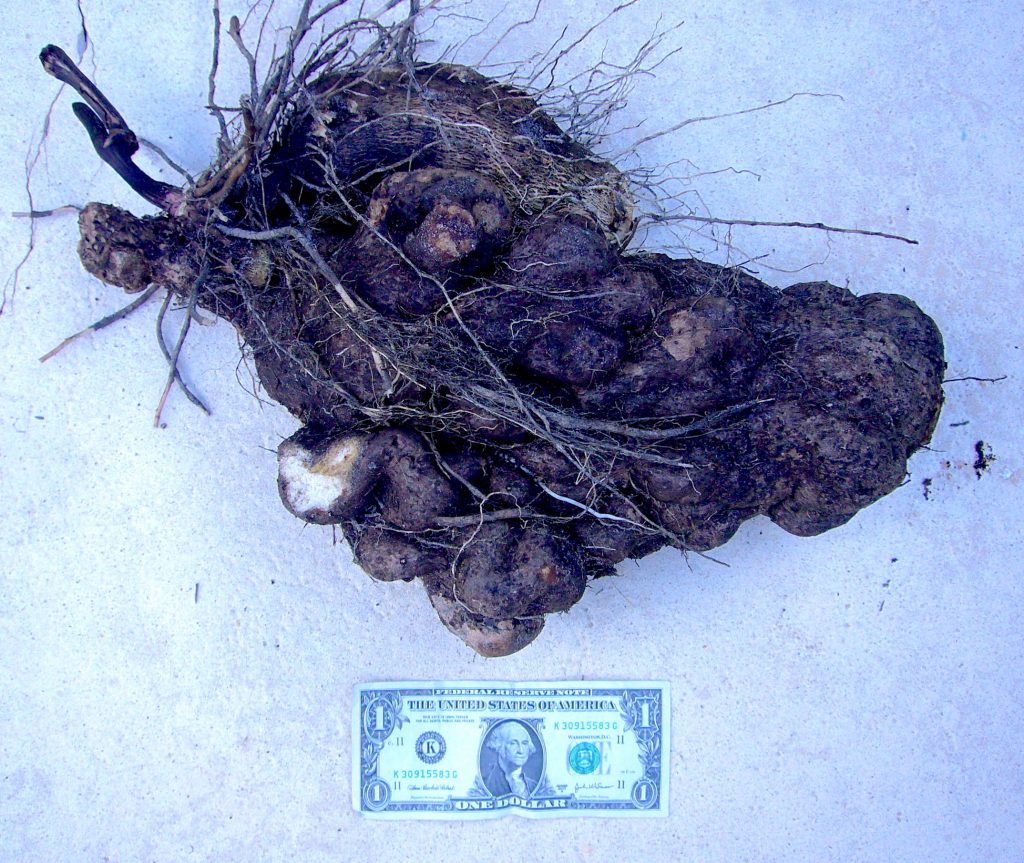
Fall is not the only time to harvest wild yams. We typically use obvious air bulbils in the fall to locate the vine often with large edible roots. But we can also locate smaller, edible roots this time of year as well. You look for the telltale square vines and pairs of opposite leaves. However, early in the season it can be a little tricky because young vines often haven’t developed pairs of leaves yet and will have singular leaves until older. However, the stem is square and the vine has what is called a Z-twist. That is at eye-level it twists from your lower left to your upper right, like the diagonal mark on the letter Z. This time of year it only takes a few minutes to dig up several small yams that can be used like potato. They are perfectly stored and well-hidden from most eyes. In the fall one can find roots from five pounds shaped like a two-liter bottle to easily 30 pound or more. To read more about the Winged Yam go here.
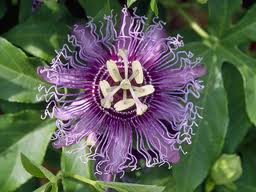
Maypops smell like gym shoes. Photo by Green Deane
It’s June and Maypops are popping out all over. They are easy to find: Look for a vine that has three-lobed leaves and smooth, green fruit shaped like a large egg to a tennis ball. The fruit ripens to yellow near the base of the vine first. The plant, which smells like an old gym shoe, will put on new fruit until cold weather. Green fruit can be fried like green tomatoes. Sometimes the green ones have seeds mature enough to be tart. Sweet and sour seeds can be scooped out of the yellow fruit and eaten along with their white jelly-like coating. Locally our most common passion fruit is Passiflora incarnata. You will read on the Internet that it contains cyanide. It does not though many passion fruits do if not all but P. incarnata. It was specifically tested and definitely does not have cyanide in it’s leaves. The varying amounts of cyanide in other species of passion fruit is one reason why animals don’t eat them and one reason why you should not eat any ornamental passion fruit you may have. Instead of cyanide P. incarnata has GABA, gamma-Aminobutyric acid, which calms you down. It might be a possible anti-dote for Water Hemlock poisoning in that Water Hemlock breaks down the body’s reserve of GABA.
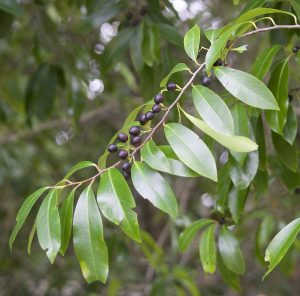
The Cherry Laurel is deadly. Do not eat it. Photo by Green Deane
As cyanide has been mentioned many plants have it, including several edible species, Chaya for example. Mechanical breaking down of plant cells or cooking often gets rid of the cyanide which many times is bound together either with sugar or hydrogen molecules. Sometimes the plant has to be fermented so the bacteria can eat the glucose thus freeing the cyanide to be rinsed away. Clearly one wants the cyanide to be released outside of the body not during digestion. The toxic non-edible Cherry Laurel is a common poisonous plant with the cyanide bond. If you crush a leaf you can smell either almonds or “maraschino” cherries. That’s cyanide. However, there is one interesting fact you should keep in mind: Depending where you are only 25 to 40% of the population can smell cyanide. It’s a gene-linked thing. If you can crush several Cherry Laurel leafs and not smell almonds or “maraschino” cherries you might be one of those who cannot use their nose to detect cyanide. You can, however, look at the backside of the leaf near the stem and find two faded dots. Those can help you identify it.

Donations to upgrade EatTheWeeds.com and fund a book are going well. Thank you to all who have contributed to either via the Go Fund Me link, the PayPal donation link or by writing to Green Deane POB 941793 Maitland FL, 32794. Recent upgrades have been paid now the Forum needs work and several function problems need to be fixed specifically the search and categories. The other issue is finding an indexing program or function for a real book. Writing programs used to do it automatically if you designated a term for indexing. Now that most books are ebooks most writing programs do not provide and indexing function.

Want to identify a plant? Looking for a foraging reference? Do you have a UFO, an Unidentified Flowering Object you want identified? On the Green Deane Forum we chat about foraging all year. And it’s not just about warm-weather plants or just North American flora. Many nations around the world share common weeds so there’s a lot to talk about. There’s also more than weeds. The reference section has information for foraging around the world. There are also articles on food preservation, and forgotten skills from making bows to fermenting food. One special section is “From the Frightening Mail Bag” where we learn from people who eat first then ask questions later. You can join the forum by clicking on “forum” in the menu.

All My Videos are available for free on You Tube. They do have ads on them so every time you watch a Green Deane video I get a quarter of one cent. Four views, one cent. Not exactly a large money-maker but it helps pays for this newsletter. If you want to see the videos without ads and some in slightly better quality you can order the DVD set. It is nine DVDs with 15 videos on each for a total of 135 videos. Many people want their own copy of the videos or they have a slow service and its easier to order then to watch them on-line. The DVDs make a good gift for that forager you know especially as spring is … springing. Individual DVDs can also be ordered or you can pick and choose. You can order them by clicking on the button on the top right hand side of this page (if your window is open wide enough.) Or you can go here.
This is weekly issue #360.

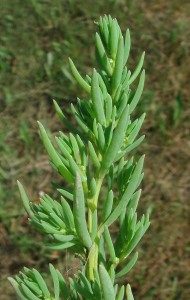

Concerning maypop, I posted a video (YouTube channel feralkevin) last fall about a fruit from the maypop plant I grew. It was not at all like all the other maypop fruits I have found from this plant or in the wild. It was incredibly full of fruit pulp and as delicious if not more so than any cultivated passionfruit (P. edulis.) The reason why this particular fruit was so good remains a mystery, as does why the plant makes thousands and thousands of flowers each year but only a dozen fruit. Also, I have been having folks in my classes sample the young leaves of the maypop raw, and they love the flavor!
I have read online that tomato leaves are edible. I know they are not wild, but have you tried them?
No, they are not edible.